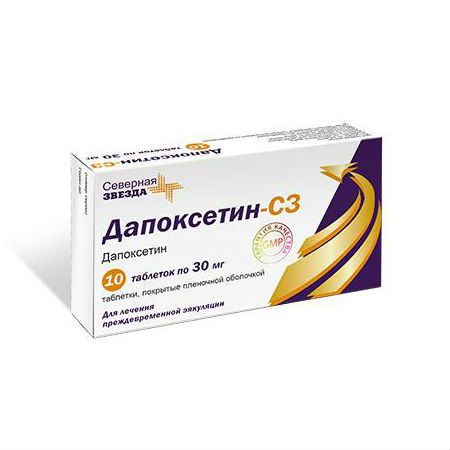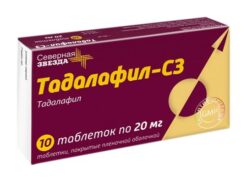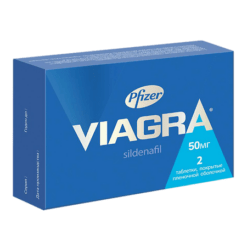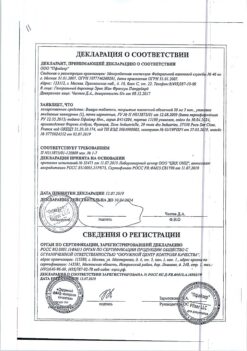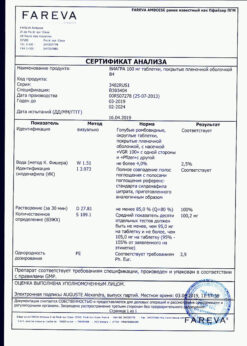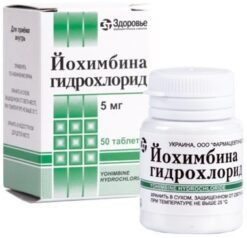No products in the cart.
Dapoxetine-SZ, 30 mg 10 pcs
€14.97 €13.98
Description
Pharmacotherapeutic group:the treatment of premature ejaculation
ATX code: G04BX14
Pharmacological properties
Pharmacodynamics
Dapoxetine is a potent selective serotonin reuptake inhibitor (SSRI) with a half-maximal inhibition concentration (IC50) of 1.12 nM, metabolized in the body to the major metabolites, desmethyldapoxetine (IC50 < 1.0 nM) and didesmethyldapoxetine (IC50 = 2.0 nM), equally or less active (dapoxetine-N-oxide (IC50= 282 nM)).
The mechanism of action of dapoxetine in premature ejaculation is associated with inhibition of serotonin reuptake by neurons with subsequent enhancement of neurotransmitter action at pre- and postsynaptic receptors.
The mechanism of ejaculation is regulated mainly by the sympathetic nervous system. In rats, postganglionic sympathetic nerve fibers innervate the seminal vesicles, seminal duct, prostate, urethral and bladder neck muscles, causing their coordinated contraction to achieve ejaculation. Dapoxetine affects the ejaculation reflex at the supraspinal level in the lateral parahygantocellular nuclei by increasing the latent period and decreasing the duration of the reflex impulse of the motoneurons of the perineal ganglia. The stimulus triggering ejaculation is generated in the spinal reflex center, which is controlled through the brain stem by several brain nuclei, including the preoptic and paraventricular.
Pharmacokinetics
Assimilation
. Dapoxetine is rapidly absorbed, and the maximum plasma concentration (Cmax) is reached 1-2 hours after taking the drug. Absolute bioavailability is 42% (range 15 – 76%) and exposure (AUC and Cmax) increases in proportion to dose between 30 mg and 60 mg. After multiple oral doses, the AUC of dapoxetine and its active metabolite desmethyldapoxetine is increased by approximately 50% compared to the AUC values after a single dose.
Eating a fatty meal moderately decreases the Cmax of dapoxetine (by 10%) and increases the AUC (area under the concentration-time curve) and time to maximum plasma concentration by 12%. These changes are not clinically significant. Dapoxetine-SZ may be taken regardless of meals.
Distribution
More than 99% of dapoxetine is bound to plasma proteins in vitro. The active metabolite, desmethyldapoxetine, binds 98.5% to plasma proteins. Dapoxetine is distributed throughout the body with an average equilibrium volume of distribution of 162 l.
Metabolism
In vitro studies suggest that dapoxetine is metabolized by many liver and kidney enzymes, especially CYP2D6, CYP3A4 and flavin-containing monooxygenase (FM01) of the kidneys. In a clinical study that examined the metabolism of
14C-dapoxetine, dapoxetine was actively metabolized after oral administration primarily by N-oxidation, N-demethylation, hydroxylation of the naphtha group, glucuronization, and attachment of the
sulfogroup. After oral administration, there are signs of presystemic metabolism in the liver. The main components circulating in plasma were intact dapoxetine and
dapoxetine-N-oxide. In in vitro studies, dapoxetine-N-oxide was found to be inactive. In addition, desmethyldapoxetine and didesmethyldapoxetine were detected in an amount less than 3% of the total amount of circulating metabolites of dapoxetine. In an in vitro study, desmethyldapoxetine was found to be comparable in activity to dapoxetine, while didesmethyldapoxetine was about 2 times less active than dapoxetine. Exposure (AUC and Cmax) of unbound desmethyldapoxetine was 50% and 23% of unbound dapoxetine, respectively.
Elimation
Dapoxetine metabolites are excreted mainly by the kidneys as conjugates. Dapoxetine is not detected unchanged in the urine. After oral administration, the initial (disposition) elimination half-life of dapoxetine is approximately 1.5 hours, plasma levels are less than 5% of peak concentrations 24 hours after administration, and the final elimination half-life is about 19 hours. With daily administration, the final half-life is approximately 19 hours.
Pharmacokinetics of dapoxetine in special patient populations
Race
A single administration of dapoxetine at a dose of 60 mg showed no statistically significant difference in performance among Caucasoid, Negroid, Hispanic, and Mongoloid races. Comparison of dapoxetine pharmacokinetics in Caucasians and Japanese showed higher Cmax and AUC values in the latter (by 10-20%) because of lower body weight. Higher systemic exposure is unlikely to cause a significant difference in clinical effect. Elderly patients (65 years and older)
An analysis of a clinical pharmacology study with a single dose of 60 mg dapoxetine showed no significant difference in pharmacokinetics (Cmax, AUC0-∞, Tmax) in healthy older men and healthy younger men.
In patients with impaired renal function
There was no clear increase in the AUC of dapoxetine with decreased renal function. The AUC of dapoxetine in patients with severe renal impairment was approximately 2 times higher than in patients with normal renal function. There are limited data on the use of the drug in patients with severe renal impairment. The pharmacokinetics of dapoxetine has not been studied in patients requiring hemodialysis.
In patients with impaired hepatic function
In patients with mild hepatic impairment, the Cmax of unbound dapoxetine was decreased by 28% and the AUC was unchanged. Cmax and AUC of active fraction (sum of unbound fractions of dapoxetine and desmethyldapoxetine) decreased by 30% and 5%, respectively. In patients with moderate hepatic impairment, the Cmax of unbound dapoxetine is generally unchanged (decreased within 3 %), and the AUC is increased by 66 %. The cmax of the unbound active fraction of dapoxetine was unchanged, and the AUC was doubled.
In patients with severe hepatic impairment, the Cmax of unbound dapoxetine was decreased by 42% and the AUC of unbound dapoxetine was increased by approximately 223%. The cmax and AUC of the active fraction varied similarly.
Polymorphism CYP2D6
. Plasma concentrations of dapoxetine after a single dose of Dapoxetine-SZ at 60 mg were higher in patients with low CYP2D6 activity than in patients with high CYP2D6 activity (Cmax by approximately 31%, AUC0-∞ by approximately 36%). Similarly, the Cmax of desmethyldapoxetine in patients with low CYP2D6 activity was increased by 98% and the AUC0-∞ by 161%. The cmax of the active fraction of Dapoxetine-SZ was increased by approximately 46% and the AUC by approximately 90%. This increase may be accompanied by an increased frequency and severity of dose-dependent adverse events. When using Dapoxetine-SZ in patients with low CYP2D6 activity, special attention should be paid to the safety in concomitant use of other drugs that may inhibit the metabolism of dapoxetine, such as moderate-acting CYP3A4 inhibitors and strong CYP3A4 inhibitors.
Indications
Indications
Dapoxetine-SZ is indicated for the treatment of premature ejaculation in men aged 18 to 64 years.
Dapoxetine-SZ may only be used in patients who meet the following criteria:
Dapoxetine-SZ should only be used as needed before intended sexual activity. Dapoxetine-SZ should not be used to delay ejaculation in men without a confirmed diagnosis of premature ejaculation.
Active ingredient
Active ingredient
Composition
Composition
1 film-coated tablet contains:
the active substance:
dapoxetine hydrochloride – 33.6 mg (in terms of dapoxetine) – 30 mg;
excipients (core):
lactose monohydrate (milk sugar) – 44.0 mg;
croscarmellose sodium (primellose) – 4.0 mg,
microcrystalline cellulose 102 – 14.9 mg,
colloidal silica (aerosil) – 2.5 mg,
magnesium stearate – 1.0 mg ;
excipients (shell): 3 mg (hypromellose – 1.64 mg; polysorbate-80 (tween-80) – 0.46 mg; talc – 0.46 mg; titanium dioxide E 171 –
0.31 mg; iron oxide yellow dye E 172 – 0.13 mg).
How to take, the dosage
How to take, the dosage
Ingestion. The tablet should be swallowed whole with at least one full glass of water. Dapoxetine-SZ can be taken regardless of meals.
The drug should not be started at a dose of 60 mg
Adult males 18 to 64 let
The recommended starting dose for all men is 30 mg; this dose is taken 1 to 3 hours before intended sexual intercourse. If the 30 mg dose is inadequate and well tolerated (no moderate to severe adverse reactions or prodromal symptoms that may precede fainting), the dose may be increased to the maximum recommended 60 mg, taken
1-3 hours before intercourse. The frequency and severity of adverse reactions are increased when the 60 mg dose is taken.
Patients in whom the administration of Dapoxetine-SZ in a dose of 30 mg is accompanied by symptoms of orthostatic hypotension should not increase the dose of the drug to 60 mg. The drug should not be taken more than once a day. The maximum daily dose with good tolerance is 60 mg.
The physician prescribing Dapoxetine-SZ for treatment of premature ejaculation should assess the risks and benefits of the drug after the first 4 weeks of treatment, or at least after the first 6 doses, and determine the risk-benefit ratio to decide whether further treatment with Dapoxetine-SZ is appropriate.
There are limited data on the efficacy and safety of dapoxetine over 24 weeks. The clinical need for continued therapy and the benefit/risk ratio of Dapoxetine-SZ should be evaluated at least every 6 months.
Patients with impaired renal function
Dose adjustment is not required for patients with mild to moderate renal impairment, but caution is recommended. Dapoxetine-SZ is not recommended for patients with severe renal impairment.
Patients with impaired liver functionc
Patients Dapoxetine-SZ is contraindicated in patients with moderate to severe hepatic impairment (Child-Pugh grades B and C).
Elderly patients (65 years and older)
The efficacy and safety of dapoxetine in patients 65 years and older have not been established.
Pazents with low activity isoenzyme CYP2D6 and patients takingsimultaneous csimultaneous CYP2inhibitors.D6
Caution should be exercised when increasing the dose of Dapoxetine-SZ to 60 mg in patients with low CYP2D6 isoenzyme activity or in patients taking Dapoxetine-SZ simultaneously with strong CYP2D6 isoenzyme inhibitors.
Patients receiving strong or moderately active CYP3A4 isoenzyme inhibitors
The concomitant use of Dapoxetine-SZ with strong CYP3A4 isoenzyme inhibitors is contraindicated. When concomitant use of Dapoxetine-SZ with moderately active CYP3A4 isoenzyme inhibitors, the dose of the drug should be reduced to 30 mg, and caution should also be exercised.
Interaction
Interaction
Interaction with monoamine oxidase inhibitors
. Serious, sometimes fatal reactions, including hyperthermia, rigidity, myoclonus, autonomic nervous system disorders with possible rapid fluctuations in vital signs, and altered mental status, including severe agitation progressing to delirium and coma, have been described in patients receiving SSRIs and monoamine oxidase inhibitor (MAOI) simultaneously. These reactions have also been observed in patients who recently discontinued SSRIs and started treatment with MAO inhibitors. In some cases, the symptoms resembled malignant neuroleptic syndrome. Data on the combined use of SSRIs and MAO inhibitors in animals suggest that these drugs may synergistically increase blood pressure and induce behavioral arousal. Therefore, dapoxetine should not be taken concomitantly with MAO inhibitors and for 14 days after stopping their administration. Similarly, MAOI inhibitors should not be taken for
7 days after stopping dapoxetine.
Interaction with thioridazine
Tioridazine prolongs the QTc interval, which is accompanied by ventricular arrhythmias. Drugs like dapoxetine, which inhibit the CYP2D6 isoenzyme, appear to inhibit the metabolism of thioridazine. The resulting increase in thioridazine levels is expected to exacerbate QTc interval prolongation. Dapoxetine should not be taken concomitantly with thioridazine and for 14 days after discontinuation. Similarly, thioridazine should not be taken for 7 days after stopping dapoxetine.
Drugs with serotonergic effects
. As with other SSRIs, concomitant use of dapoxetine with serotonergic drugs (including MAO inhibitors, L-tryptophan, triptans, tramadol, linezolid, SSRIs, serotonin and norepinephrine takeover inhibitors, lithium, and preparations of Hypericum perforatum) may increase the frequency of serotonergic adverse reactions. Dapoxetine should not be taken concomitantly with other SSRIs, MAO inhibitors, and other serotonergic drugs and for 14 days after discontinuation of these drugs. Similarly, these medications should not be taken for
7 days after discontinuation of dapoxetine.
Drugs acting on the CNS
. The use of dapoxetine concomitantly with drugs acting on the central nervous system (e.g., antiepileptic drugs, antidepressants, neuroleptics, anxiolytics, sedative hypnotics) has not been studied in patients with premature ejaculation. Therefore, caution is recommended if concomitant use of these drugs is necessary.
Effects of other drugs on the pharmacokinetics of dapoxetine
. Studies using human liver, kidney, and intestinal microsomes in vitro have shown that dapoxetine is metabolized primarily by CYP2D6, CYP3A4, and flavin-containing monooxygenase 1 (FM01). Therefore, inhibitors of these enzymes may decrease the clearance of dapoxetine.
CYP3A4 inhibitors
Powerful CYP3A4 inhibitors
Ketoconazole administration at a dose of 200 mg twice daily for 7 days increased Cmax and AUC0-â of dapoxetine (60 mg once) by 35% and 99%, respectively. Given the proportion of unbound dapoxetine and desmethyldapoxetine, the Cmax of the active fraction (sum of unbound dapoxetine and desmethyldapoxetine) in the presence of strong CYP3A4 inhibitors may increase by approximately 25% and the AUC may double. This increase in Cmax and AUC of the active fraction may be significantly more pronounced in a subpopulation of patients without a functionally active CYP2D6 enzyme, such as weak CYP2D6 metabolizers, and when taking strong CYP2D6 inhibitors simultaneously.
Hence, use of dapoxetine concomitantly with strong CYP3A4 inhibitors such as ketoconazole, itraconazole, ritonavir, saquinavir, telithromycin, nefazodone, nelfinavir and atazanavir is contraindicated.
Inhibitors CYP3A4medium potency
. Concomitant use with medium-acting CYP3A4 inhibitors, such as erythromycin, clarithromycin, fluconazole, amprenavir, fosamprenavir, aprepitant, verapamil, or diltiazem, can significantly increase the systemic effects of dapoxetine and desmethyldapoxetine, especially in patients with low CYP2D6 activity. These two measures apply to all patients except those who have been identified as active CYP2D6 metabolizers by gene or phenotyping. In patients who are classified as active CYP2D6 metabolizers, a maximum dose of 30 mg is recommended when dapoxetine and a strong CYP3A4 inhibitor are used concomitantly. Caution should be exercised when dapoxetine 60 mg and a moderately potent CYP3A4 inhibitor are used concomitantly.
Severe inhibitors CYP2D6
. Administration of fluoxetine at a dose of 60 mg/day for 7 days increased Cmax and AUC0-â of dapoxetine (60 mg once) by 50% and 88%, respectively. Given the proportion of unbound dapoxetine and desmethyldapoxetine, the Cmax of the active fraction (sum of unbound dapoxetine and desmethyldapoxetine) in the presence of strong CYP2D6 inhibitors may increase by approximately 50% and the AUC may double. This increase in Cmax and AUC of the active fraction is close to that expected in patients with low CYP2D6 activity and may result in increased frequency and severity of dose-dependent adverse reactions. Therefore, caution is recommended when increasing the dose of dapoxetine to 60 mg in patients receiving active CYP2D6 inhibitors and in patients with low CYP2D6 activity.
Phosphodiesterase 5 (PDE5)
The pharmacokinetics of dapoxetine taken at a dose of 60 mg simultaneously with tadalafil (20 mg) or sildenafil (100 mg) were studied in a single-dose cross-over study. Tadalafil had no effect on the pharmacokinetics of dapoxetine. Sildenafil caused slight changes in the pharmacokinetics of dapoxetine: increased AUC0-â and Cmax (by 22% and 4%, respectively), which is considered clinically insignificant. Dapoxetine should be administered with caution to patients taking FDE5 inhibitors because of potentially reduced tolerance to orthostatic hypotension. Concomitant use of dapoxetine with FDE5 inhibitors may lead to orthostatic hypotension. The efficacy and safety of dapoxetine in patients with premature ejaculation and erectile dysfunction taking dapoxetine and FDE5 inhibitors concomitantly have not been studied.
Effects of dapoxetine on concomitant medications
Tamsulosin
Tamsulosin. Single and multiple dapoxetine doses of 30 mg and 60 mg in patients receiving daily tamsulosin did not alter the pharmacokinetics of the latter. The incidence of orthostatic hypotension was also unchanged and was similar when tamsulosin alone and when tamsulosin was combined with dapoxetine 30 mg or 60 mg. Dapoxetine should be prescribed with caution in patients taking alpha-adrenoblockers because of their potentially reduced tolerance to orthostatic hypotension.
Drugs metabolized by CYP2D6
Multiple dapoxetine administration (60 mg/day for 6 days) increased Cmax and AUC0-â desipramine (50 mg once) by 11% and 19%, respectively, compared with administration of desipramine alone. Dapoxetine may similarly increase plasma concentrations of other drugs metabolized by CYP2D6. The clinical significance of this is likely to be small.
Drugs metabolized by CYP3A
. Repeated administration of dapoxetine (60 mg/day for 6 days) reduced the AUC0-â of midazolam (8 mg once) by approximately 20% (range -60% to +18%). The clinical significance of this phenomenon in most patients is likely to be small. However, the increase in CYP3A activity may be of clinical significance in some patients concomitantly taking drugs metabolized primarily by CYP3A and with a narrow therapeutic index.
Drugs metabolized by CYP2C19
Repeated administration of dapoxetine (60 mg/day for 6 days) did not inhibit the metabolism of omeprazole (40 mg once). Dapoxetine is unlikely to affect the pharmacokinetics of other CYP2C19 substrates.
Drugs metabolized by CYP2C9
. Repeated administration of dapoxetine (60 mg/day for 6 days) had no effect on the pharmacokinetics and pharmacodynamics of glibenclamide (5 mg once). Dapoxetine presumably does not affect the pharmacokinetics of other CYP2C9 substrates either.
Warfarin and drugs that inhibit blood clotting and/or platelet function.
There are no data on the effects of long-term warfarin administration simultaneously with dapoxetine. Caution is recommended when prescribing dapoxetine to patients taking warfarin for a long time. In a pharmacokinetic study, repeated administration of dapoxetine
(60 mg/day for 6 days) had no effect on the pharmacokinetics and pharmacodynamics (PV and INR) of warfarin (25 mg once). There have been cases of abnormal bleeding when concomitant use with SSRIs.
Ethanol
Single administration of ethanol (0.5 g/kg or approximately 2 doses) had no effect on the pharmacokinetics of dapoxetine (60 mg once) and vice versa. However, concomitant administration of dapoxetine and ethanol increased drowsiness and significantly impaired vigilance in patients’ own assessment. Pharmacodynamic measurements of cognitive impairment (digital attention rate test, digital character replacement test) also revealed the presence of additive effects when dapoxetine and ethanol are used simultaneously. Simultaneous administration of ethanol and dapoxetine increases the frequency and severity of adverse reactions such as dizziness, drowsiness, slowed reflexes, and altered judgment. It may also increase neurocardiogenic adverse reactions, particularly the frequency of syncope, which increases the risk of accidental injury. Therefore, patients should be advised to refrain from taking alcohol during dapoxetine treatment.
Special Instructions
Special Instructions
General
Dapoxetine should only be used in patients with premature ejaculation who meet the criteria listed under “Indications for Use. Dapoxetine should not be used in men who have not been diagnosed with premature ejaculation. The safety of the drug in men without premature ejaculation has not been established, and there are no data on delayed ejaculation.
Consumption with narcotic drugs
Patients should not take dapoxetine with narcotic drugs. Concomitant use of dapoxetine with drugs with serotonergic activity, such as ketamine, methylenedioxymethamphetamine (MDMA), and lysergic acid diethylamide (LSD), may result in potentially serious reactions, including but not limited to arrhythmia, hyperthermia, and serotonin syndrome. Use of dapoxetine concomitantly with sedatives such as opiates or benzodiazepines may increase drowsiness and dizziness.
Consumption with ethanol
The co-administration of dapoxetine with alcohol may increase its effects on the central nervous system and may also increase neurocardiogenic adverse reactions such as syncope, thereby increasing the risk of accidental injury. Therefore, patients should be advised to refrain from taking alcohol while taking dapoxetine.
Fainting
Patients should avoid potentially traumatic situations, particularly driving or operating machinery, if fainting or its prodromal symptoms, such as dizziness or preconsciousness, occur (see side effects). Patients who received dapoxetine were more likely than patients who received placebo to experience prodromal symptoms, including nausea, dizziness/pre-consciousness, and increased sweating.
The cases of fainting, characterized as loss of consciousness, with bradycardia or sinus node arrest in patients on Holter monitoring, observed in clinical trials were attributed to vasovagal origin, and most occurred within the first 3 hours after administration, after the first dose, or were associated with medical procedures (blood draws, body position changes, blood pressure measurement). Possible prodromal symptoms such as nausea, dizziness, preconsciousness, palpitations, asthenia, confusion, and increased sweating were also commonly observed in the first 3 hours after taking the drug and often preceded fainting. Patients should be informed that fainting with or without prodromal symptoms may occur at any time during treatment with dapoxetine. The physician should inform the patient of the importance of adequate water exercise and of recognizing prodromal signs and symptoms to reduce the risk of serious injury if a possible fall due to loss of consciousness occurs. If possible prodromal symptoms occur, the patient should immediately lie down so that the head is below the torso, or sit with the head between the knees, and remain in this position until the symptoms disappear. If fainting or other adverse central nervous system reactions occur, the patient should be warned to avoid potentially traumatic situations, including driving or operating machinery.
Patients at risk of cardiovascular disease
Dapoxetine clinical trials have not included patients with cardiovascular disease. Patients with organic heart and vascular disease (e.g., cardiac ejection obstruction, valve lesions, carotid artery stenosis, coronary artery atherosclerosis) have an increased risk of adverse cardiovascular consequences of fainting of cardiac and other origin. However, there are currently insufficient data to determine whether this risk extends to vasovagal syncope in patients with cardiovascular disease.
Ortostatic hypotension
Before initiating therapy, the physician should perform a thorough physical examination, including a history of orthostatic events, and an orthostatic test (measurement of blood pressure and heart rate while sitting and standing). A history of confirmed or suspected orthostatic reactions should be avoided with dapoxetine.
Cases of orthostatic hypotension have been described in clinical studies. The physician should inform the patient beforehand that if possible prodromal symptoms occur, e.g., dizziness immediately after standing up, the patient should immediately lie down so that the head is below the trunk, or sit down with the head between the knees, and stay in this position until the symptoms disappear. In addition, the patient should be informed to avoid standing abruptly after prolonged lying or sitting.
Inhibitors CYP3A4medium potency
. Caution should be exercised when dapoxetine is used concomitantly with moderate-acting CYP3A4 inhibitors (erythromycin, clarithromycin, fluconazole, amprenavir, fosamprenavir, aprepitant, verapamil, diltiazem) and the drug dose should be reduced to 30 mg.
Severe inhibitors CYP2D6
. Caution is advised when increasing the dose of dapoxetine to 60 mg in patients receiving strong CYP2D6 inhibitors and in patients with low CYP2D6 activity, as this may increase systemic exposure to the drug with a corresponding increase in the frequency and severity of dose-related adverse reactions.
Suicidal ideation/suicidal thoughts
In short-term studies, antidepressants, including SSRIs, compared with placebo more strongly increased the risk of suicidal ideation and suicidality in children and adolescents with major depressive disorder and other psychiatric disorders. In short-term studies, no increase in suicidality risk was found with antidepressants compared with placebo in adults over 24 years of age. In clinical trials of dapoxetine for the treatment of premature ejaculation, no clear evidence of suicidal ideation during treatment as assessed by the Columbia Classification Algorithm for Suicide Assessment
(C-CASA), Montgomery-Asberg Depression Rating Scale, or Beck Depression Questionnaire was found.
Mania
Dapoxetine should not be taken in patients with a history of mania/hypomania or bipolar disorder and the drug should be stopped if symptoms of these conditions appear.
Convulsions
Because of the ability of SSRIs to lower the seizure threshold, dapoxetine should be avoided in patients with unstable epilepsy and the drug should be stopped if seizures occur. Patients with controlled epilepsy require close monitoring.
Take in children and adolescents younger than 18 years
The use of dapoxetine in patients younger than 18 years and older than 65 years is contraindicated because there are no clinical data on the effectiveness and safety of dapoxetine in these patient populations.
Companion Depression and/or Psychiatric Disorders
If a patient has signs and symptoms of depression, an evaluation should be performed to rule out the presence of an undiagnosed depressive disorder before starting dapoxetine. Dapoxetine should not be taken concomitantly with antidepressants, including SSRIs and serotonin and norepinephrine reuptake inhibitors. It is not recommended to discontinue treatment for depression or anxiety before starting dapoxetine treatment. Dapoxetine is not intended to treat psychiatric disorders (such as schizophrenia or depression) and should not be taken by men with these conditions, as an increase in symptoms of depression cannot be ruled out. Any disturbing thoughts or feelings should be reported to your doctor immediately, and if signs and symptoms of depression appear during treatment, dapoxetine should be stopped.
Bleeding
Bleeding has been described when using SSRIs. Caution is recommended when taking dapoxetine concomitantly with drugs that affect platelet function (e.g., atypical neuroleptics, phenothiazines, acetylsalicylic acid, nonsteroidal anti-inflammatory drugs (NSAIDs), anticoagulants (such as warfarin), and in patients with a history of bleeding or clotting disorders.
Kidney function impairment
Dapoxetine is not recommended for patients with severe renal impairment, patients with mild to moderate renal impairment should exercise caution.
Cancellation syndrome
There is evidence that abrupt withdrawal of SSRIs used for long-term treatment of chronic depressive disorders leads to the following symptoms Decreased mood, irritability, agitation, dizziness, sensory disturbances (such as paresthesia as an electric shock sensation), anxiety, confusion, headache, drowsiness, emotional instability, insomnia, and hypomania.
In a clinical study conducted to evaluate the “withdrawal” effect of dapoxetine after 60 days of dosing at a dose of 60 mg daily in patients with premature ejaculation, no signs of “withdrawal” syndrome were found. After patients were switched to placebo after daily dapoxetine administration, only minor withdrawal symptoms in the form of mild to moderate insomnia and dizziness were detected.
Other types of sexual dysfunction
Patients with other types of sexual dysfunction, including erectile dysfunction, should be carefully evaluated by a doctor before starting treatment. Dapoxetine should not be used in patients with erectile dysfunction receiving FDE5 inhibitors.
Drugs with vasodilating properties
Dapoxetine should be used with caution in patients taking drugs with vasodilating properties (such as alpha-adrenoblockers and nitrates) due to possible decreased orthostatic tolerance.
Visual disorders
In the background of dapoxetine use, adverse visual reactions such as mydriasis and eye pain have been reported. Dapoxetine should be used with caution in patients with elevated intraocular pressure or risk of closed-angle glaucoma.
Influence on driving and operating ability
Dapoxetine has a slight to moderate effect on the ability to drive and operate machinery. Cases of dizziness, impaired attention, fainting, blurred vision, and drowsiness have been described when taking dapoxetine. The patient should be warned to avoid situations in which injury may occur, including driving vehicles and operating machinery. Concomitant use of alcohol and dapoxetine may increase alcohol-related neurocognitive effects and may also increase the risk of neurocardiogenic adverse reactions, such as syncope, which in turn increases injury risk. Thus, patients should be advised to avoid concomitant use of alcohol when using Dapoxetine-SZ.
Synopsis
Synopsis
Contraindications
Contraindications
– Hypersensitivity to dapoxetine and/or any excipient in the drug.
– Severe heart disease (e.g., chronic heart failure class II-IV according to NYHA, cardiac conduction disorders (atrioventricular conduction block or sinus node weakness syndrome); diagnosed coronary heart disease; heart valve disease.
– Concomitant use of monoamine oxidase inhibitors (MAOIs) and administration of dapoxetine for 14 days after discontinuation of the MAOI inhibitor. Accordingly, MAOI inhibitors should not be taken within 7 days after discontinuation of Dapoxetine-SZ.
– Simultaneous use of thioridazine and for 14 days after discontinuation of its use. Accordingly, thioridazine should not be taken for 7 days after discontinuation of Dapoxetine-SZ.
– Simultaneous use of selective serotonin reuptake inhibitors (SSRIs); serotonin reuptake inhibitors, norepinephrine and tricyclic antidepressants; other drugs with serotoninergic effects (e.g.
L-tryptophan, triptans, tramadol, linezolid, lithium, preparations of St. John’s wort [Hypericum perforatum]) and for 14 days after discontinuation of these drugs. Accordingly, these drugs should not be taken for 7 days after discontinuation of Dapoxetine-SZ.
– Concurrent use with strong CYP3A4 inhibitors, such as ketoconazole, itraconazole, ritonavir, saquinavir, telithromycin, nefazodone, nelfinavir, atazanavir, etc.
– In patients with moderate to severe hepatic impairment.
– In patients with severe renal insufficiency.
– In patients under 18 years of age and over 64 years of age (due to lack of data on the efficacy and safety of dapoxetine in these patient populations).
– Lactose intolerance, lactase deficiency, glucose-galactose malabsorption syndrome.
– Syncopal condition in the anamnesis.
– A history of manic state or severe depression.
– In the presence of diagnosed or suspected orthostatic hypotension.
– Dapoxetine-SZ should not be used in patients with mania/hypomania or bipolar disorder.
With caution
– In patients with mild to moderate renal impairment;
– concomitant use with strong CYP2D6 isoenzyme inhibitors and medium CYP3A4 inhibitors in patients with genotypically low CYP2D6 isoenzyme activity and patients with high CYP2D6 isoenzyme activity (in combination with medium CYP3A4 inhibitors);
– concomitant use with drugs that affect platelet aggregation and with anticoagulants because of the risk of bleeding, as well as in patients with a history of bleeding or clotting disorders.
Side effects
Side effects
The following adverse reactions have been reported in clinical trials and were frequent and dose-dependent: nausea
(11.0% and 22.2% when taking 30 mg and 60 mg dapoxetine, respectively), dizziness (5.8% and 10.9%), headache (5.6% and 8.8%), diarrhea
(3.5% and 6.9%), insomnia (2.1% and 3.9%), fatigue (2.0% and 4.1%).
The most common reactions that required treatment withdrawal were nausea (in 2.2% of patients) and dizziness (1.2% of patients).
The adverse reactions observed during clinical trials of dapoxetine are categorized into systemic organ classes with the frequency of occurrence according to WHO recommendations:
Mental disorders
Anxiety, agitation, restlessness, unusual dreams, decreased libido
Depression, depressed mood, euphoric states, mood swings, nervousness, indifference, apathy, confusion, disorientation, pathological thinking, somatosensory amplification, sleep disturbances, initial insomnia, intrasomnia disorder, nightmares, bruxism, loss of libido, anargosmia
Nervous system disorders
Dizziness, headache
Drowsiness, impaired concentration, tremor, paresthesia
Fainting, including vasovagal syncope, postural dizziness, akathisia, taste disorder, hypersomnia, somnolence, sedative effect, depressed consciousness
Dizziness on physical exertion, sudden falling asleep
br> Visual disturbances Blurred vision Midriasis, pain in the eyes, visual disturbances
Hearing organ and labyrinth disorders
Tinnitus
Tinnitus
/p>
Vertigo
Disorders in the heart
Cessation of sinus node activity, sinus bradycardia, tachycardia
vascular disorders
“Hot flashes” of blood (skin hyperemia), increased arterial
pressure
Decreased blood pressure, increased systolic blood pressure, increased diastolic blood pressure, orthostatic hypotension “hot flashes”
Discomfort in the abdomen, discomfort in the epigastric region Emergency urges to defecation
Strong>Skin and subcutaneous tissue disorders
Hyperhidrosis
Itching, cold sweat
Gender organ disorders
Overdose
Overdose
No cases of overdose have been described.
The administration of dapoxetine at doses up to 240 mg (2 doses of 120 mg at 3-hour intervals) has not caused any unexpected adverse reactions. In general, symptoms of SSRI overdose include serotonergic reactions, including drowsiness, gastrointestinal disturbances (nausea, vomiting), tachycardia, tremor, agitation, and dizziness.
In case of overdose, standard supportive therapy should be administered, if necessary. Due to the significant binding of the drug to plasma proteins and the large volume of distribution of dapoxetine, forced diuresis, dialysis, hemoperfusion and blood transfusion are unlikely to be effective. A specific antidote is not known.
Pregnancy use
Pregnancy use
Similarities
Similarities
Additional information
| Shelf life | 3 years. Do not use after the expiration date stated on the package. |
|---|---|
| Conditions of storage | In the dark place at the temperature not more than 25 °С. Keep out of reach of children. |
| Manufacturer | North Star NAO, Russia |
| Medication form | pills |
| Brand | North Star NAO |
Related products
Buy Dapoxetine-SZ, 30 mg 10 pcs with delivery to USA, UK, Europe and over 120 other countries.

